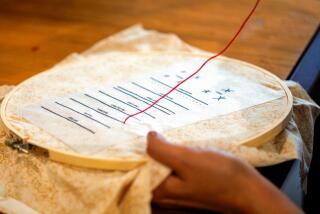A Seamstress With a Passion for Her Craft
- Share via
At an age when most little girls are content to simply play with dolls, Kathy Crammer was sewing doll clothes, making outfits at 4.
“I started sewing on my mother’s sewing machine,” recalls Crammer, now 52 and an accomplished couturiere.
The Whitehall, Pa., woman said she inherited her knack for sewing from her grandmother, who had been a New York City seamstress.
The old machine that belonged to her mother is one of seven in Crammer’s sewing room. Another room is set aside for storing and cutting fabric, which she buys and saves for future projects. A closet is stacked with yards and yards of fabric purchased over the years.
Crammer is one of 30 million women in the United States who are serious sewers. Cathleen Campbell, director of marketing for the New York-based Home Sewing Assn., said most of those women aren’t sewing out of necessity but rather as a hobby.
“Sewing is viewed more as a creative activity,” Campbell said. Today’s home sewer makes her own clothes, home decor and also sews for her children, she said.
According to the 1992 Census of Retail Trade, sales affiliated with sewing, which include everything from machines and fabric to notions, craft materials and knitting supplies, were estimated at $5.1 billion.
Sew News magazine’s 1999 survey of 180,000 readers reported that sewers are spending an average of $657 a year on fabrics and notions alone.
Crammer undertook a challenge this year to create a dress made with a solid fabric and a fabric with a clock design to represent the millennium.
Crammer’s dress has fabric-covered buttons down the front. She made sure each of the clocks on the buttons showed the same time.
Getting professional results is an art for sewers such as Crammer, whose selection of machine is based on the job she intends to do.
One does everything from buttonholes to a zigzag stitch. Another creates only a blind stitch, which creates a hem that is not visible on the outside of the garment. Crammer’s serger, which cuts and sews material at the same time with an interlocking stitch, prevents fabric from fraying.
Crammer’s three other machines are used as backups in case one breaks.






